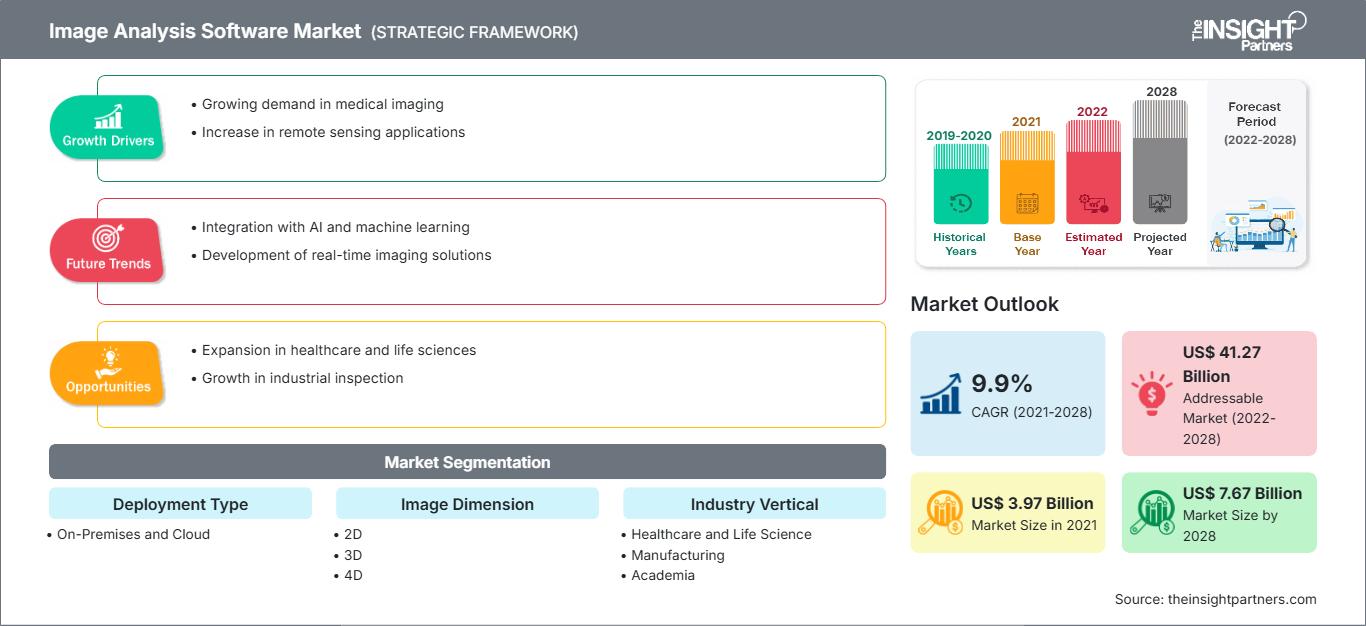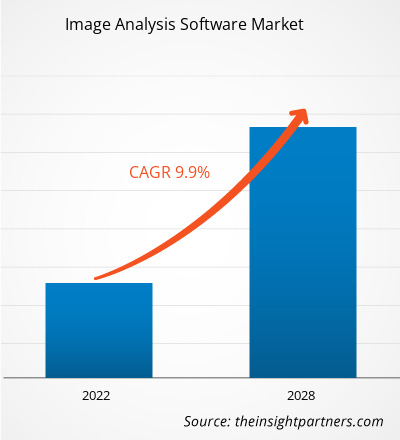[調査レポート]画像分析ソフトウェア市場は、2021年の39億7,093万米ドルから2028年には76億7,216万米ドルに成長すると予想されており、2021年から2028年にかけて9.9%のCAGRで成長すると予測されています。
画像分析ソフトウェア市場は、画像分析市場とも呼ばれ、デジタル画像処理技術を用いて、主にデジタル画像などの写真から貴重なデータを抽出するのに役立ちます。画像分析タスクは、バーコードタグのスキャンのような単純なものから、人物の顔認識のような複雑なものまで多岐にわたります。膨大な量のデータ、複雑な計算を必要とするジョブ、定量的データの抽出にはコンピューターが必要です。コンピューターまたは電気機器が写真を分析して使用可能な情報を抽出することを、デジタル画像分析またはコンピューター画像分析と呼びます。パターン認識、デジタル幾何学、信号処理をコンピュータービジョンやマシンビジョン、医用画像処理の領域に統合します。人工知能(AI)と機械学習(ML)を活用した画像解析ソフトウェアアプリケーションは、自動車業界に新たな定義をもたらします。現在、自動車製造業界では、設計、サプライチェーン、生産、ポストプロダクションの分野でAIが活用されています。さらに、AIと機械学習は「運転支援」や「運転者リスク評価」システムにも活用され、運輸業界に革命をもたらしています。人工知能は、予知保全や保険など、様々なアフターマーケットサービスにも変革をもたらしています。自動車業界では、機械学習によって新しいインテリジェント製品の開発や作業方法の改善が実現しています。
形状の検出、エッジの認識、ノイズの低減、オブジェクトのカウント、テクスチャ分析や画質のための統計情報の生成などは、すべて画像解析タスクの例です。画像解析とは、2次元(2D)または3次元(3D)のデジタル画像を定量的または定性的に特徴付ける作業であり、コンピュータービジョンは2D画像を分析し、医用画像処理は3D画像を分析します。画像解析ソフトウェアは、顕微鏡画像解析や科学画像の研究に広く利用されています。画像解析ソフトウェア市場の成長は、主にヘルスケアおよびライフサイエンス業界におけるソフトウェアの広範な導入によって牽引されています。
要件に合わせてレポートをカスタマイズ
レポートの一部、国レベルの分析、Excelデータパックなどを含め、スタートアップ&大学向けに特別オファーや割引もご利用いただけます(無償)
画像解析ソフトウェア市場: 戦略的洞察

-
このレポートの主要な市場動向を入手してください。この無料サンプルには、市場動向から見積もりや予測に至るまでのデータ分析が含まれます。
COVID-19パンデミックによる画像解析ソフトウェア市場への影響
COVID-19パンデミックは、画像解析ソフトウェア市場に利益をもたらしました。企業は、COVID-19パンデミックとリモートワーク環境の発展により、新たな課題に直面しています。COVID-19の発生は、様々な業界の企業がデジタル技術を採用し、画像解析ソフトウェア市場のソリューションとサービスの可能性を活用して業務とコストを最適化する必要性を浮き彫りにし、ITツールのROIをさらに高めます。さらに、2020年のパンデミックの到来は、世界の画像解析ソフトウェア市場の運営に多くの課題をもたらしました。先進国の医療インフラは、COVID-19の症例の増加により崩壊しています。したがって、公衆衛生上の緊急事態には、政府と市場プレーヤーが介入し、予測期間中に損失を回復するために実施される研究開発イニシアチブの共同努力を通じて、画像解析ソフトウェア市場の運営と収益の回復を支援する必要があります。さらに、投資の増加は、今後数年間の画像分析ソフトウェア市場にとって良い前兆です。
画像分析ソフトウェア市場の洞察:画像分析対応のセキュリティアプリケーションおよび製品の需要の高まり
企業は、非構造化データからリソースを引き出す可能性に気づき始めています。写真や動画を使用して、小売、エンターテイメント、保険金請求などの業界で、ユニークで魅力的な消費者体験を生み出すことができます。画像分析は、ますます多くの企業のユースケースをサポートするために使用されます。ディープラーニングと画像分析のこれらの実用的なアプリケーションは、機械学習アルゴリズムの進歩、データセットの可用性、およびリアルタイム処理を可能にするプラットフォームを備えた堅牢なテクノロジーの存在によって実現されています。米国の多くの空港では、指紋や虹彩スキャンなどの生体認証を代替セキュリティスクリーニング手法として利用できるように機器をアップグレードしています。企業は、到着ゲートから保安検査場、出発ゲートまで乗客を運ぶ画像解析技術を導入することで、キャパシティの大幅な向上を見込んでいます。
画像解析ソフトウェア市場 - 導入タイプ別セグメントの洞察
導入に基づいて、画像解析ソフトウェア市場はオンプレミスとクラウドに分かれています。オンプレミスソフトウェアは、サーバーファームやクラウドなどのリモート施設ではなく、ユーザーまたは組織の敷地内のコンピューターにインストールされ、運用されます。オンプレミスソフトウェアは柔軟性、安定性、セキュリティに優れているため、現在、複数の市場プレーヤーがオンプレミスソフトウェアを販売しています。たとえば、オンプレミスImaggaのビジュアルAIソリューションは、企業のプライベートローカルサーバーに完全に導入できます。データに敏感な組織は、プライバシー法と規制に完全に準拠しながら、Imagga の受賞歴のあるビジュアル AI テクノロジーを使用して、自動タグ付け、自動分類、色抽出、カスタム トレーニング、顔認識を実行できます。
画像分析ソフトウェア市場 - 画像ディメンション セグメントの洞察
画像ディメンションに基づいて、画像分析ソフトウェア市場は 2D、3D、4D に分類されます。2D 画像は、x 軸と y 軸を使用して作成されます。伝統的に、2D 画像はアニメーションやビデオのソースとして使用されてきました。長い歴史を持つ古いテクノロジーですが、今でも定番となっているのには理由があります。これらの画像はシンプルで視覚的に魅力的であり、顧客を圧倒したり邪魔したりすることなく簡単に利用できます。2D 画像は、画面上でリアルでありながらフラットな動きの視点を提供するため、アニメーションやビデオ ゲームでよく使用されます。そのため、業界のいくつかの企業は現在、2D 写真を分析するソフトウェアを提供しています。例えば、Media Cybernetics, Inc. の Image-Pro Plus 2D 画像解析ソフトウェアは、写真の収集、アイテムのカウント、測定、分類を簡単に行うことができ、作業を自動化できます。顕微鏡制御、画像キャプチャ、測定、カウント/サイズ、マクロ開発機能はすべてこのソフトウェアパッケージに含まれています。
画像解析ソフトウェア市場 - 業種別セグメントの洞察
業種別に見ると、画像解析ソフトウェア市場は、ヘルスケア・ライフサイエンス、製造、学術、鉱物・金属・石油、その他に分類されています。医療業界では、画像解析ソフトウェアは神経学、心臓病学、整形外科、歯科、腫瘍学など、様々な分野で活用されています。このソフトウェアは、X線、MRI、CTスキャン、PETスキャン、超音波検査で作成された画像を読み取ることができます。その結果、プロセスを自動化・加速化することで、手作業を減らし、時間を節約できます。ソフトウェアはこれらの写真の特定の特徴を認識するように学習することで、診断手順を迅速かつ正確に行うことができます。医療用画像処理ソフトウェアには多くの機能があります。 AIベースのソリューションは、不規則性や潜在的に危険な異常を検出し、患者が癌なのか良性腫瘍なのかを示します。このソフトウェアは、通常の2D画像(時間経過による変化を表示する画像)に加えて、3Dやいわゆる4D写真も読み取ることができます。
画像解析ソフトウェア市場
画像解析ソフトウェア市場のプレーヤーは、競争力を高めるために高度な技術と機能を統合することで、新製品のイノベーションと開発に注力しています。2021年10月、Clemex Visionには、マルテンサイト、フェライト、オーステナイトの結晶粒に関する独自の指示とML機能が追加されました。これらの新しい自動化手法は、既存のソフトウェアのツールボックスに追加され、困難な微細構造を視覚的に識別するための迅速かつ正確な手法を提供します。
展開タイプに基づいて、画像解析ソフトウェア市場はオンプレミスとクラウドに分かれています。画像のサイズに基づいて、画像解析ソフトウェア市場は2D、3D、4Dに分類されています。画像解析ソフトウェア市場は、業界別に見ると、ヘルスケア・ライフサイエンス、製造業、学術研究、鉱物・金属・石油、その他に分類されています。地域別に見ると、世界の画像解析ソフトウェア市場は、北米、ヨーロッパ、アジア太平洋地域、中東・アフリカ、南米に分類されています。
画像解析ソフトウェア市場の地域別分析
予測期間全体を通して画像解析ソフトウェア市場に影響を与える地域的な傾向と要因については、The Insight Partnersのアナリストが詳細に説明しています。このセクションでは、北米、ヨーロッパ、アジア太平洋、中東・アフリカ、中南米における画像解析ソフトウェア市場のセグメントと地域についても解説しています。
画像解析ソフトウェア市場レポートの範囲
| レポート属性 | 詳細 |
|---|---|
| の市場規模 2021 | US$ 3.97 Billion |
| 市場規模別 2028 | US$ 7.67 Billion |
| 世界的なCAGR (2021 - 2028) | 9.9% |
| 過去データ | 2019-2020 |
| 予測期間 | 2022-2028 |
| 対象セグメント |
By 展開タイプ
|
| 対象地域と国 |
北米
|
| 市場リーダーと主要企業の概要 |
|
画像解析ソフトウェア市場のプレーヤー密度:ビジネスダイナミクスへの影響を理解する
画像解析ソフトウェア市場は、消費者の嗜好の変化、技術の進歩、製品メリットへの認知度の高まりといった要因によるエンドユーザー需要の高まりに牽引され、急速に成長しています。需要が高まるにつれ、企業は製品ラインナップの拡充、消費者ニーズへの対応、そして新たなトレンドの活用を進めており、これが市場の成長をさらに加速させています。

- 入手 画像解析ソフトウェア市場 主要プレーヤーの概要
画像解析ソフトウェア市場 –会社概要
- ADCIS SA
- Bio-Rad Laboratories, Inc.
- Oxford Instruments
- Clemex Technologies, Inc.
- Media Cybernetics, Inc.
- MIPAR Software LLC
- オリンパス法人
- Pax-it
- PerkinElmer, Inc.
- TissueGnostics GmbH
- Leica Microsystems GmbH
- MVTec Software GmbH
- Carl Zeiss AG
- Scale AI, Inc.
- Labelbox, Inc
- V7株式会社
- 過去2年間の分析、基準年、CAGRによる予測(7年間)
- PEST分析とSWOT分析
- 市場規模価値/数量 - 世界、地域、国
- 業界と競争環境
- Excel データセット
最新レポート
関連レポート
お客様の声
購入理由
- 情報に基づいた意思決定
- 市場動向の理解
- 競合分析
- 顧客インサイト
- 市場予測
- リスク軽減
- 戦略計画
- 投資の正当性
- 新興市場の特定
- マーケティング戦略の強化
- 業務効率の向上
- 規制動向への対応






















 無料サンプルを入手 - 画像解析ソフトウェア市場
無料サンプルを入手 - 画像解析ソフトウェア市場